| Shortcuts to different sections | ||||||||||||
| Group 3 | Strips | Evidence for two panes | Key items | Mis-numbering? | Anomalies | Group 3 Plate | EIM Home | Evidence | Research | Plating-Group-1 | Plating-Group-2 | Postscript |
Here is a break-down of Group 3. (1/6d) scans by quantities and column.
| Column | 1 | 2 | 3 | 4 | 5 | 6 | 7 | 8 | 9 | 0 | Total |
|---|---|---|---|---|---|---|---|---|---|---|---|
| Qty | 7 | 9 | 10 | 6 | 14 | 9 | 10 | 9 | 6 | 8 | 88 |
Some of the Group-3 scans are rather low resolution and will not be very good for plating.
My efforts to plate Group-3 have a few problems.
I have no scans of tête-bêche pairs, only 1 remainder with a margin at the top larger than the normal distance between stamps,
and similarly only one remainder with a large margin at the bottom..
Therefore it is likely to need a lot more images to complete this. There is also evidence of some mis-numbering, though it could turn out to be substituted clichés.
There is though evidence of there being two panes, see B02875 and B02725 on the 'Evidence' page.
The long strips of 1/6 stamps will be helpful, but more vertical pairs of remainders are also needed.
Another difficulty is that the value is written much more consistently in Group 3 than in the other groups.
It is not so easy to separate panes base on differences in the way the value is written.
I will assume initially that there are two panes of 5 rows of 10 stamps, the same way up, but with a separation between of unknown size.



These will be very helpful in constructing rows of stamps, but sorting out where the rows go relative to each other is more problematic.
It needs vertical pairs/blocks and stamps with selvedge at the top or bottom wider than the spacing between rows.
Remainders will play an essential part in that.
I will go over the key items and what they tell me about the 'island' within the sheet that they represent. I can build outwards from them.
The stamps below show more evidence of there being two different panes.
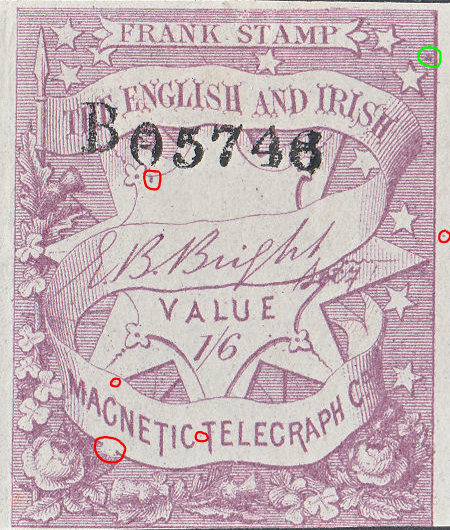 |
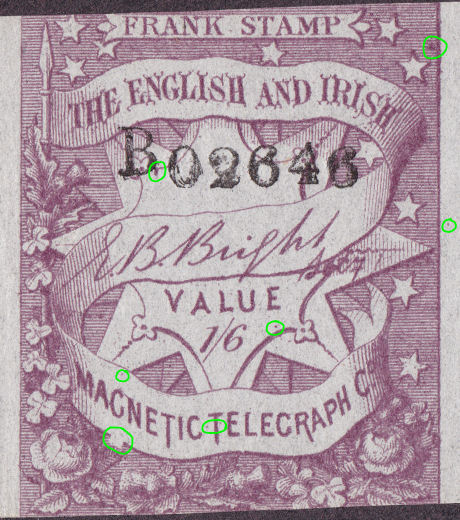 |
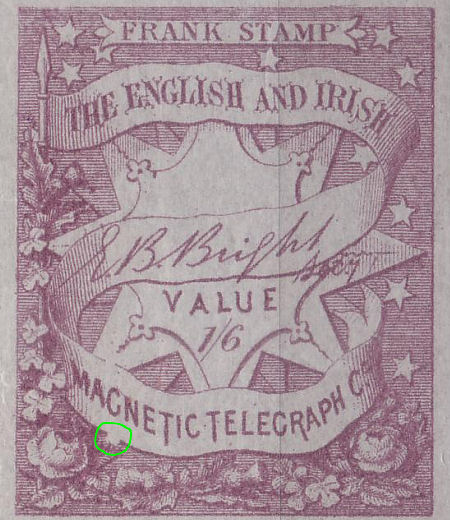 |
| B05746 and B02646 appear to have pretty much identical flaws. | This remainder, one of a block of four, has many of the same flaws, but is missing the one at the top-right. Note that the value appears to be written the same. |
|
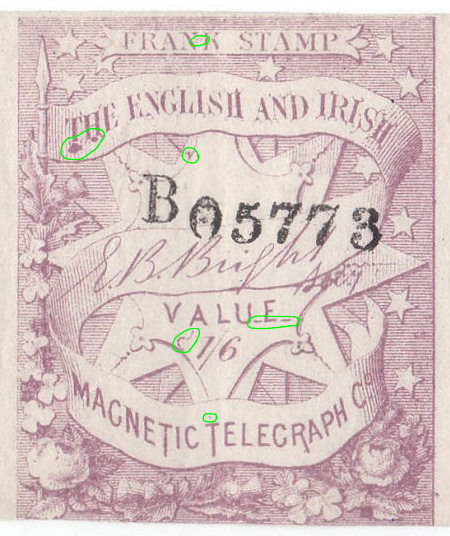 |
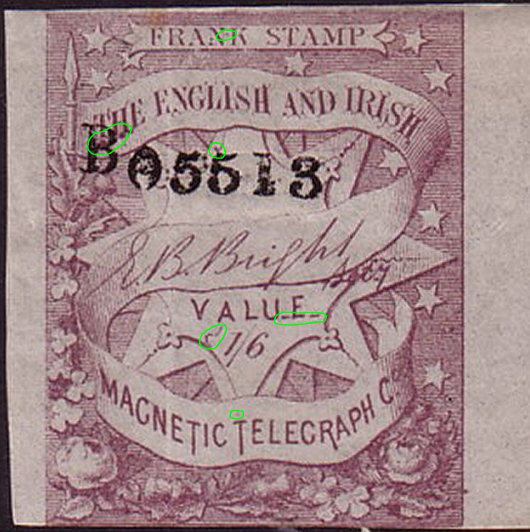 |
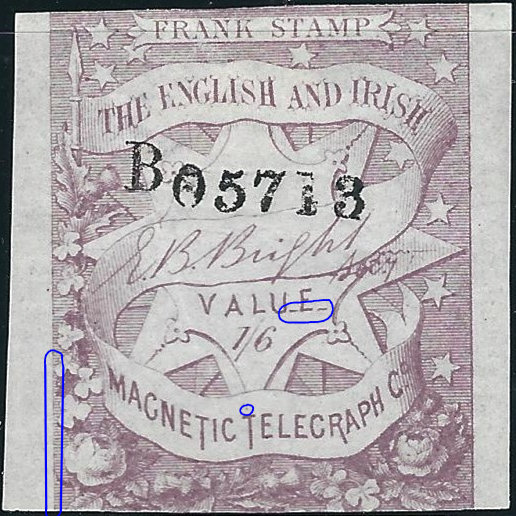 |
| B05773 and B05513 appear to have pretty much identical flaws. | B05713
has a distinctive flaw in common, but is missing a couple of distinctive flaws too. |
|
Looking at the bottom strip shown above, specifically B05776, this has flaws matching the remainder image I have with largest selvedge at the top.
The second largest selvedge remainder matches B05779 on the same strip as B05776 shown below.
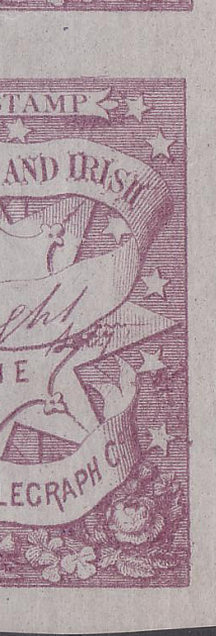 |
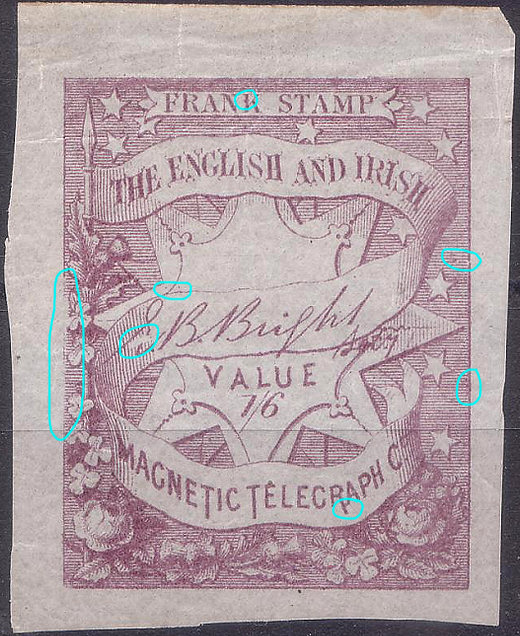 |
. . 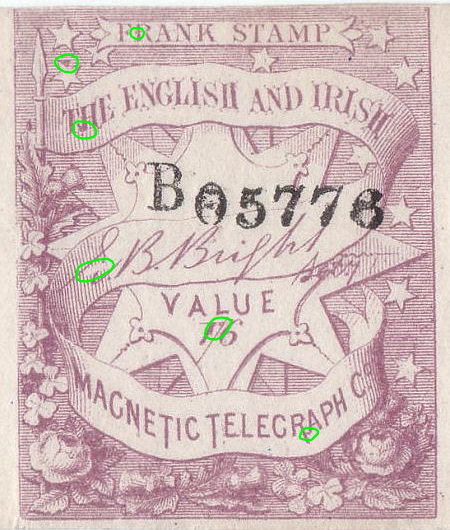 |
| Spacing between a vertical pair. | Key item 1. Wide selvedge at the top of a remainder. | Flaws on B05776 for comparison with remainder. |
Though there isn't much in it, the selvedge on top of the remainder is wider than the vertical spacing between these stamps, though it has to be said that the spacing is variable.
There are similarities between this remainder and B05776, notably the flaw on the signature. There are also notable differences.
I am assuming that there are two similar panes of 50, but at this point, I do not know the separation between the two. It may be that the gap was the same
as normal spacing, or it may be that it was substantially more, allowing for the sheet to be guillotined into two sheets of 50.
The next Key item helps with this. Look at this remainder from the bottom of a pane. Again, I have only one scan of such.
 |
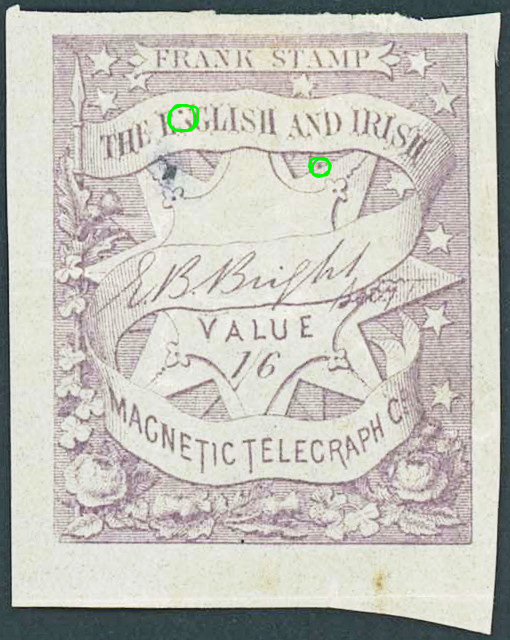 |
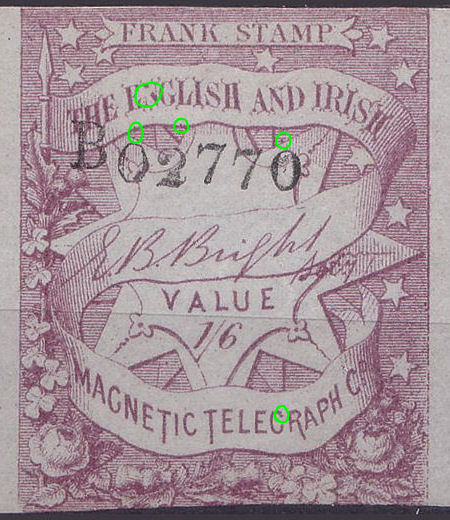 . . . |
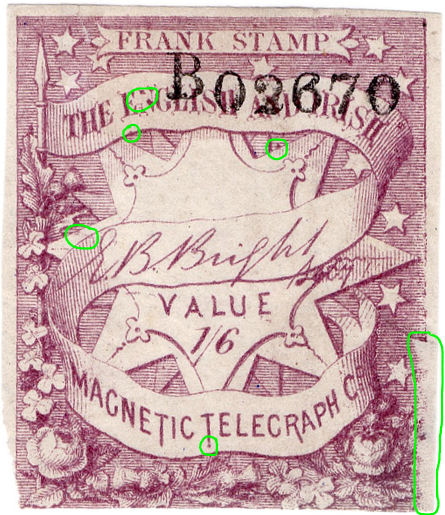 . . . . |
| Again, normal spacing for comparison. |
Key item 2. This not only has a wide margin at the bottom, but also a crease that someone was cutting along with scissors, deviating at the end. It would seem pointless to do this if it was a few millimeters from the bottom of a sheet and only makes sense if the crease was between two panes. |
This B02770 looks much like the remainder, so I would take it as being from Pane 1. |
This B02670 has extra flaws and so I would take it as being from Pane 2. |
| Stamps on the same strips as either of these would be on the bottom row of a pane. So far I don't have any. | |||
This tells me that there was a significant gap between panes, so that Key item 1 could be the top of either of the panes.
Previously I defined the strip containing B05776 as being pane 1, but now I will define the top pane in the
sheet as being pane 1, and for the moment assume that this strip was from the top of the sheet.
No real difference in practice unless I get a scan of a remainder block that spans the two panes.
I have gained the impression (see Key item 3) that in each position, the two panes have the values written identically.
If that is the case, then it would seem that the values were added to a pane of 50 stamps and then that pane was duplicated to produce the other pane.
Alternatively, one 'master block' could have produced both panes.
| Though perhaps a little redundant, this pair shows the opposite pane and gives a comparison of the ways the writing of the value varies between different stamps against the same stamp on different panes. |
||
| Column 9 Scans available: B02639 and B05779 |
Column 0 Position does not match 2810, 5520, 2750, 2770 or 2780. |
There are a number of matching flaws, but also some differences. I have now concluded that they are from a different pane. |
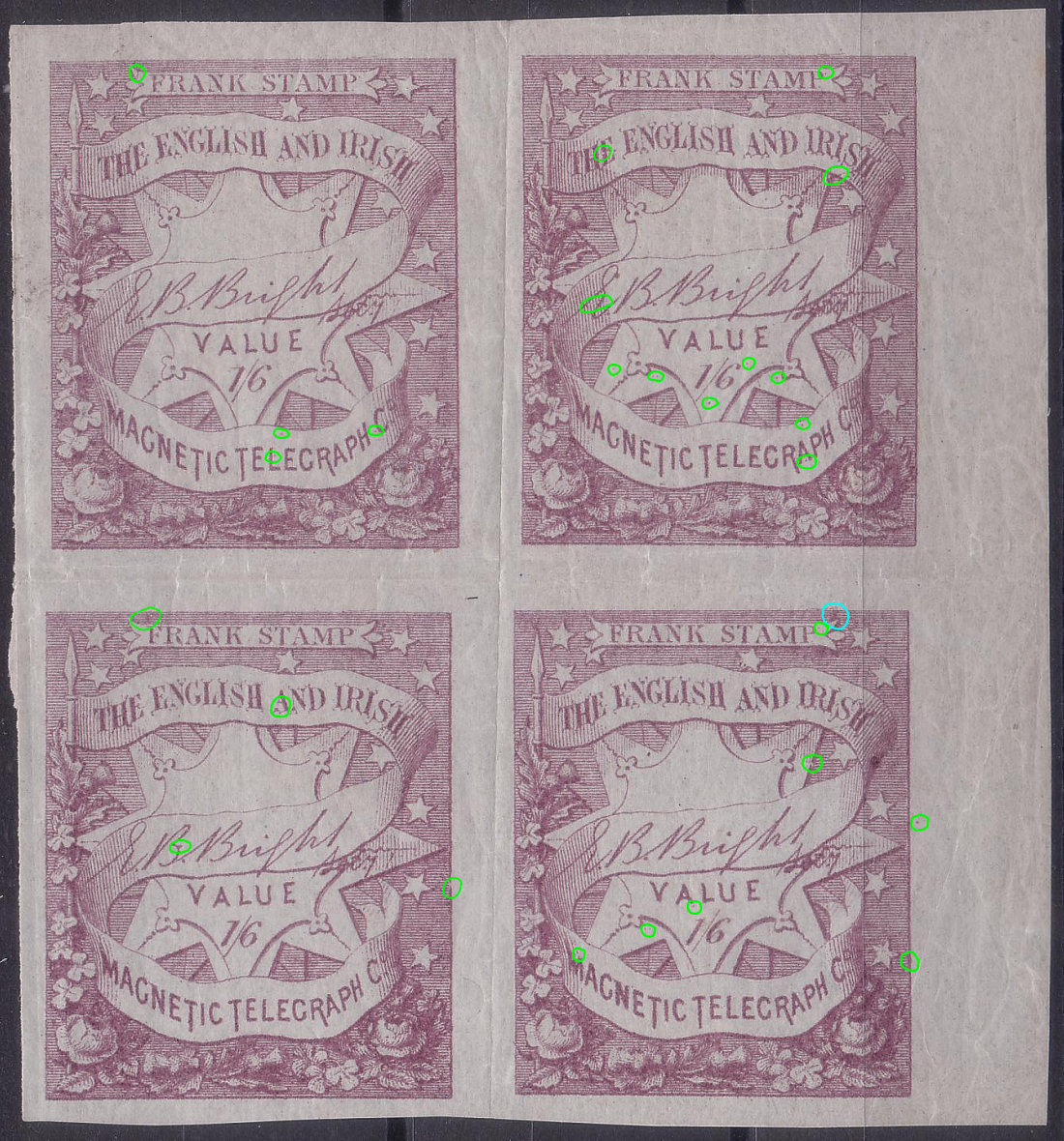 |
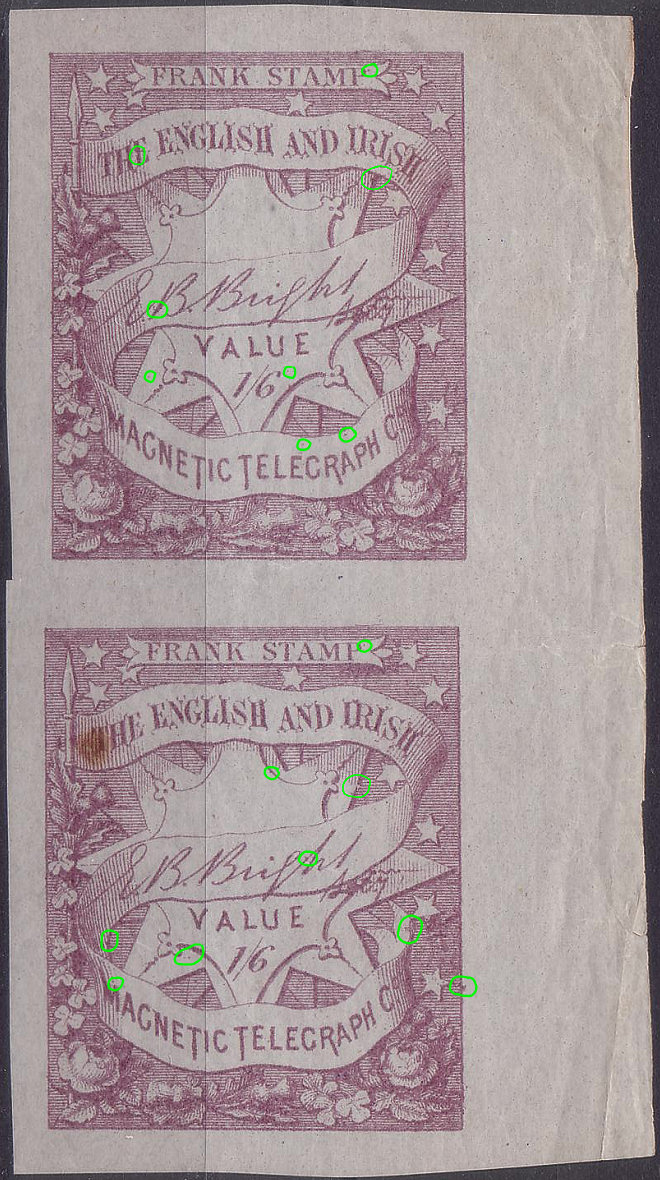 |
|
| Column 9 This matches B05539 |
Column 0 This matches B02780 and B05540 |
Strangely, the bottom matches B02780, but the top matches B02781. However they match better the two from the block of 4. See below. |
For the moment, rather arbitrarily, I have assigned the block to Rows B and C of pane 2 and the pair to pane 1.
The stamps B05539 and B05540 shown above, are on the same strip as B05535 which matches B02875 at 5C.
B02875 is on one of the strips shown at the top, running from B02871 to B02877, so I place that on pane 2 also.
For the moment, rather arbitrarily, I have assigned the block to Rows D and E of pane 1.
For the moment I have no way to determine the actual rows of most strips or blocks. All I can do is maintain consistency.
Later corrections can be made as I get vertical pairs/blocks to extend consistency between rows.
I will use the term 'park' to indicate that I have allocated a provisional place in the sheet which does not conflict with other information.
Whilst it is my best guess, it is only that and may need to be corrected as more information is found.
Key item 5.This was a lucky find, particularly with the very distinctive stamp on the right-hand end.

B02526 has distinctive flaws matching B02635, B02745 and B05675 at 5d pane 2, but is an even better match to a couple of remainders, one in a block of 4 at 5D pane 1.
I had the image of B02523 (courtesy of Steve Lawrie) some time ago, when I got the strip of 3, I originally thought that these were mis-numbered because B02526 matched 5D so well.
However B02524 did not match position 3D. Then I noticed that B02525 matches 5B. It is strange that 5D should be such a good match for 6B !
There were a number of examples that I thought were mis-numbered because of conflicts. Evidence suggests that they were in fact stamps belonging to the B-row that
for some, as yet unexplained reason, are very similar to stamps in the D-row, but generally shifted by 1 column. It could turn out to be substituted clichés.
Examples have already been found on the Bonelli's 6d and numerous Electric Telegraph 1s examples. Their existence on the EIM stamps could explain some of the anomalies shown below.
Here is some evidence that I recently came across.
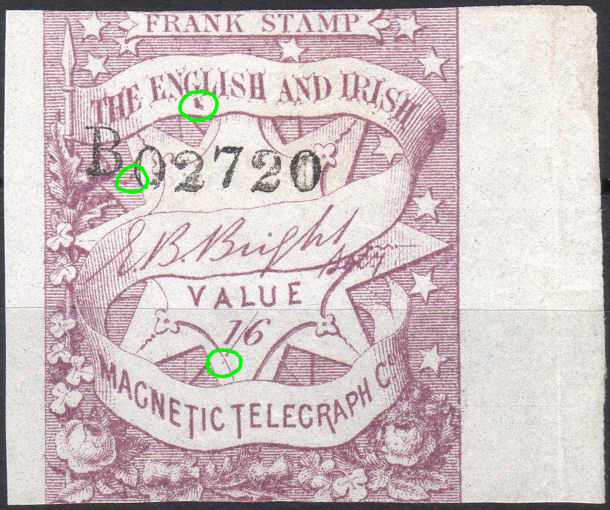
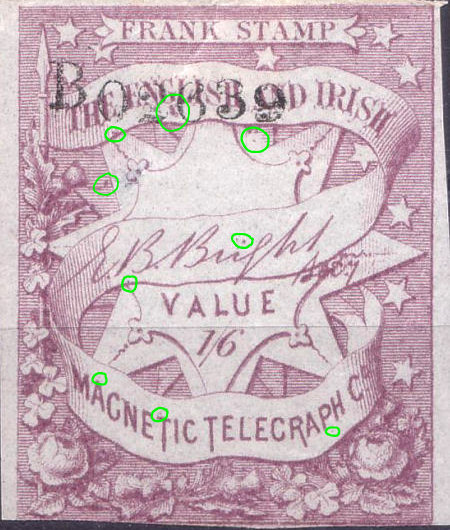
B02720 on the left has selvedge, making it clearly column 0. The flaw under the "GL" of "ENGLISH" together with another below-left are quite distinctive.
B02639 to the right shares those flaws and adds some more, particularly a void below "A" of "AND".
B02720 is on the same strip as B02711, B02712 and B02717.
B02639 is on the same strip as B02633, B02635 and B02636
None of those seem to have any conflicts. It seems likely that one of the above pair is a substitute. There is no direct evidence as to which.
The B02711-2720 strip is not tied to any row. Stamps on the edges of sheets though, are more prone to damage.
If B02720 is a substitute for the "Remainders" currently at b0/B0, then that would imply that those "Remainders" were actually earlier and really proofs (seemingly unlikely).
Alternatively I have that row in the wrong place. All the column zero positions are similarly tied to "remainders" except the "A" row which is tied indirectly through the B05513-5520 strip.
It all makes this a bit of an anomaly.
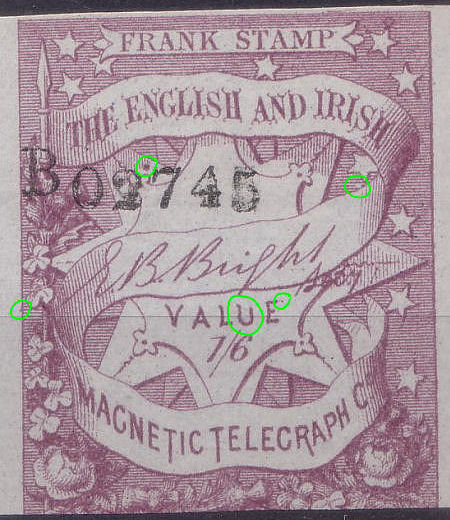 |
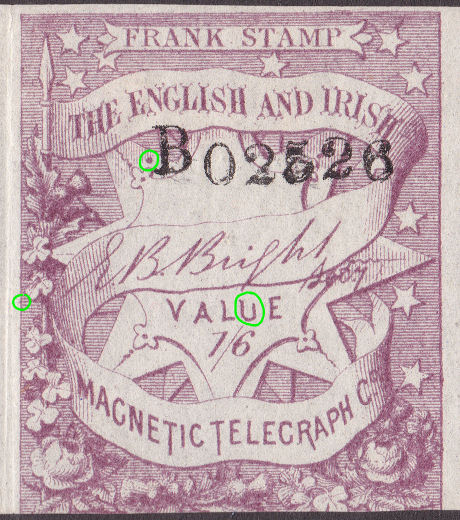 |
| Group 3, Column 5, Type aa on B02635, B02745 and B05675. I will 'park' this at 5d-pane 2 . |
Group 3, Column 6, Type c on B02526. This is on the same strip from B02523 to B02526. Placing at 6B-pane 1 . |
| These two are amazingly similar and caused me to think B02526 was mis-numbered. I now know that it isn't. Perhaps some of my other images that I have put down as mis-numbered, actually are not. |
|
There are a number of examples that are thought to be mis-numbered because of conflicts. There are also stamps allocated on the basis of their numbering alone.
In light of this result, I re-evaluated some others that were thought to be mis-numbered:
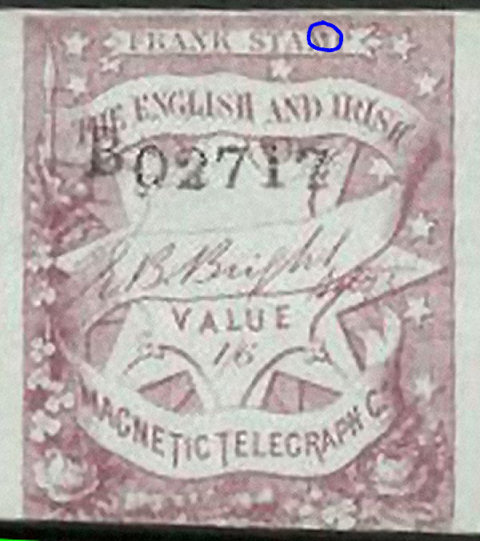 |
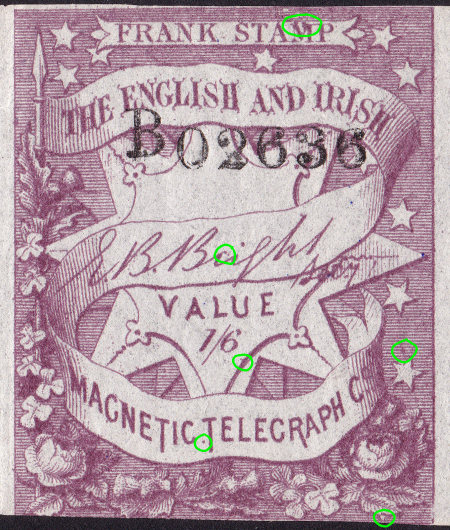 |
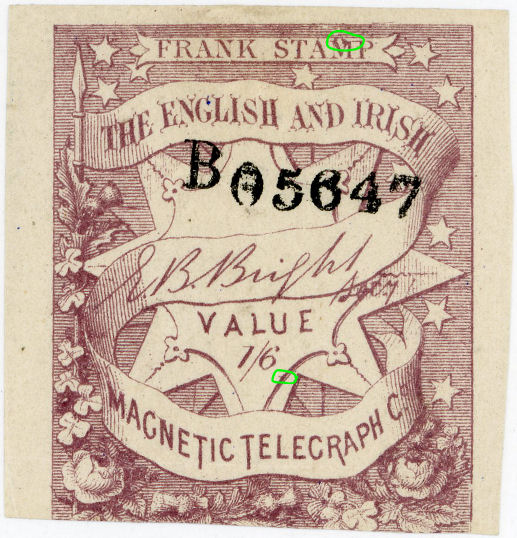 |
| B02717 - matches 6D on Key item 4, so is mis-numbered ? (it is on the same strip as B02712 above) |
B02636 - matches 6D pane 2, on Key item 4 | B05647 - matches 6D on Key item 4, is it mis-numbered ? This is on the same strip as Bo5642 below. |
| These 3 have similar flaws. | ||
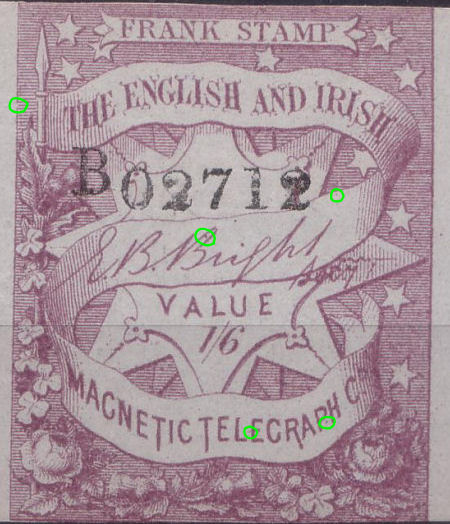 |
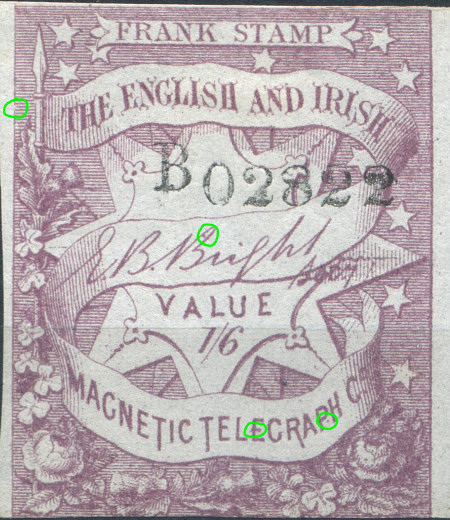 |
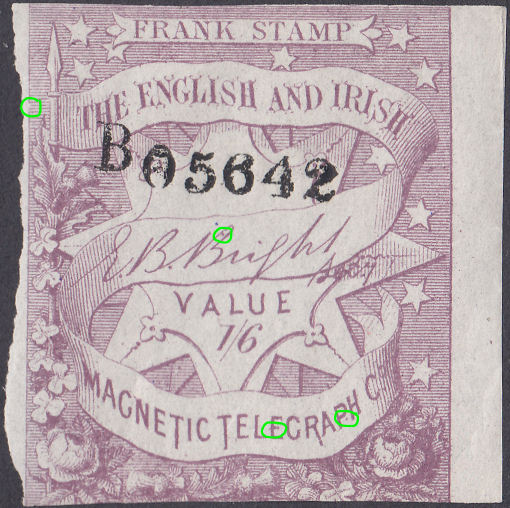 |
| B02712 - this is on the same strip as mis-numbered B02717 above. | B02822 - since this matches the stamps each side and has the same last digit, it is reasonable to assume that it is also mis-numbered and should be B02821. |
B05642 - this is on the same strip as B05647 above |
| These 3 have the same flaws. They all end with a '2' it seems very unlikely that they should all really be from column 1. | ||
It turns out that if I assume that none of those are mis-numbered but are similarly from the B-row and have these similarities for an, as yet, unknown reason,
then all these conflicts go away without creating any new conflicts. It also populates the B-row which had been strangely empty previously.
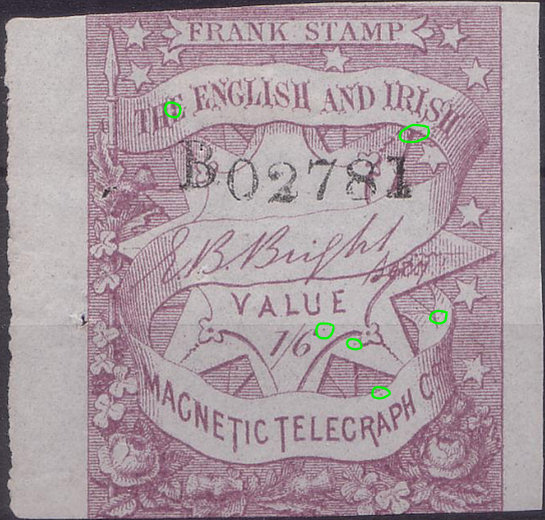 |
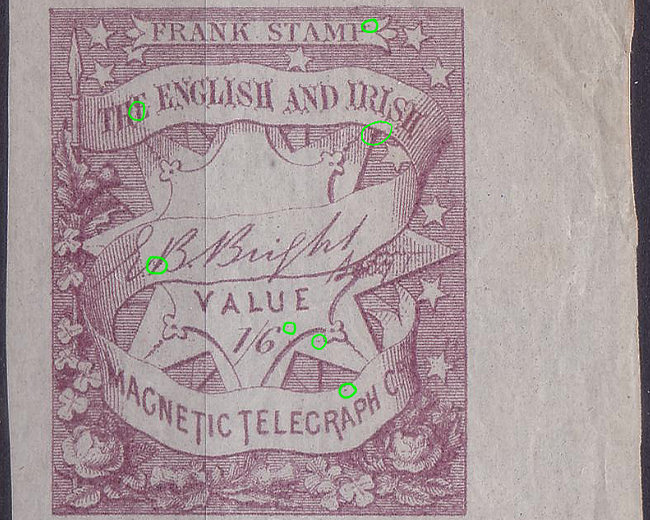 |
| B02781 - currently allocated at 1E pane 1. | Top stamp of pair, currently allocated to 0B pane 1. |
| These two have very similar flaws, but clearly one is from the first column and the other is from the last column. There is a similar one in the block of Key item 3 on the right side, but nothing matches the stamp on the left side. B02781 is on the same strip as B02785 which matches B02645 on a long strip at the bottom. The value on these is written lower than any of the stamps currently fully occupying column 1. |
|
This is intriguing, here are four example stat appear to belong at position 0A. There are similarities and differences, presumably due to there being two panes.
They are in sequence by control number with the first and last being allocated to pane 1. The key feature is the white mark on the leaf at the bottom-left.

"Normally", it would be expected that the control numbers would be in the sequence that the sheets were printed. "Normally", B02800 and B02810 would likely be from the same sheet (before separating panes).
B02810 appears to have had some repair to the center of the right side, so presumably problems had bee noticed. B05520 has much better side frames. Despite the numbering, it could actually be ab earlier sheet.
Alternatively it could be a substituted cliche using a 0A. As always. more examples are needed.
| B05771 | B05772 Rem-2A |
B05513 B05773 |
B05514 B05774 Rem-4A |
B05515 B05775 |
B05776 | B05697 B05777 |
B05778 Rem-8A-a |
B05699 B05779 Rem-9A |
B02660 B05520 |
|
|---|---|---|---|---|---|---|---|---|---|---|
| B05761 | B05642 | B02523 | B02524 | B02525 | B02526 | B05647 | B02568 Rem-8B |
B02689 | Pr-1-t | |
| B02516 Rem-2C |
Rem-3C | B05654 | B02725 Rem-5C |
B02726 B05656 |
B02727 | Pr-1-b | ||||
| B02701 | Rem-3D | Blk-2-tl Rem-5D |
Blk-2-tr | Rem-0d-1 Rem-0d-2 |
||||||
| B05751 B02781 |
B02732 | Rem-3E | B02785 B05625 Blk-2-bl |
Blk-2-br | B02738 | B02770 Rem-0e |
||||
| B05592 | B05713 Rem-3A |
Rem-6A | B05547 | B05718 Rem-8A-b |
B02809 | B02800 B02810 |
||||
| B02711 | B02712 B02822 |
B02614 | B05525 B05575 |
B02717 | Blk-1-tl | Blk-1-tr | ||||
| B02871 | B02872 | B02873 Rem-3Cb Rem-3Cc |
B02874 Rem-4C |
B02875 B05535 |
B02876 | B02877 | B05538 | B05539 Blk-1-bl |
B05540 B02780 Blk-1-br |
|
| B02543 B02633 B02843 B05503 |
B02635 B02745 B05675 |
B02636 B05676 6da 6db |
B02547 Rem-7Da Rem-7Db |
B02848 B02748 |
B02639 Rem-9D a Rem-9D b |
B02750 Rem-0d |
||||
| B05581 | B05582 | B02643 B05583 R-3Dp2 |
B02644 B05664 |
B02645 B05665 Rem-5e |
B02646 B05746 |
B02647 B05587 Rem-7E |
B02648 B05668 B05748 |
B02670 | ||
Click on control numbers to see image.
Some of these items are of stamps (B05515, B05602 and B05718) that can be seen here - BT Archive.
Notes:
I have previously characterised some anomalies as being the result of misnumbering. Since then a number of clear examples of substituted cliches has come to light among GB Private Telegraph stamps.
Because of that, I am now more inclined to believe that anomalies may be the result of such substituted clichés.
| Breakdown of flaws by column: | |||||||||
| Column-1 | Column-2 | Column-3 | Column-4 | Column-5 | Column-6 | Column-7 | Column-8 | Column-9 | Column-0 |
For Group 3, I have 6 scans from column 1, but 1 is poor. Looking at these:
 |
 |
| Group 3, Column 1, Type a on B05771. Quite a few flaws, some may be constant. Assumed as 1A-pane 1. |
Group 3, Column 1, Type b on B02701. Quite a few flaws, some may be constant. This has no selvedge on the left, but has pin-holes. I will arbitrarily 'park' this at 1D-pane 1, but seem to have too many in column 1. |
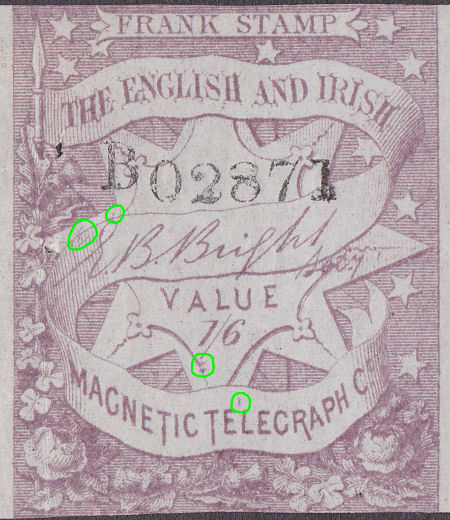 |
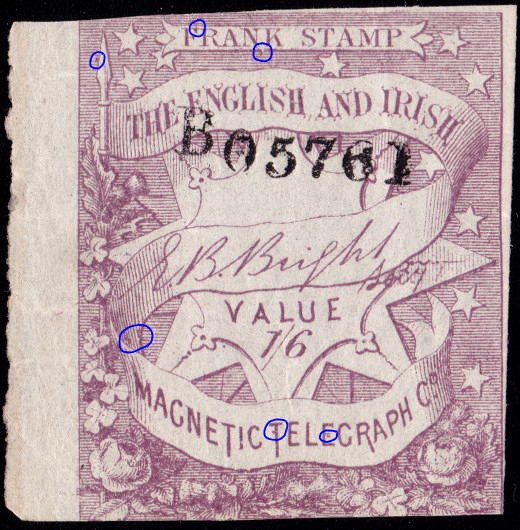
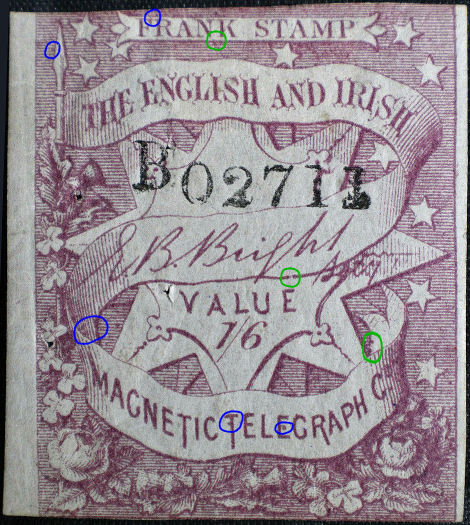 |
| Group 3, Column 1, Type c on B02871. A few flaws, some may be constant. Designated as 1c-pane 2. |
Group 3, Column 1, Type d on B05761 and B02711 (courtesy of jtheis2012 on eBay) share most but not all flaws. Quite a few common flaws, some differences. B02711 is on the same strip as B02712 and B02717. I will 'park' B05761 at 1B-pane 1, and I will 'park' B02711 at 1b-pane 2 to be on the same strip as B02712 and B02717. |
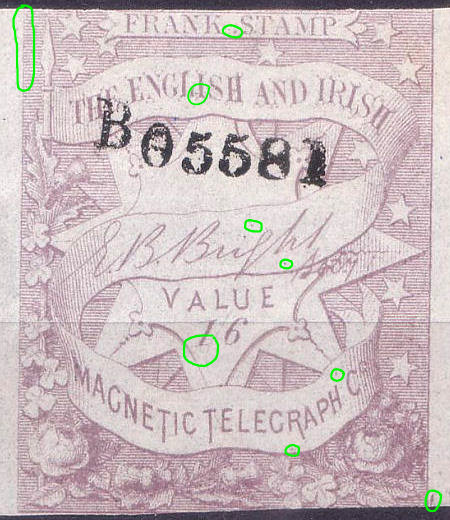 |
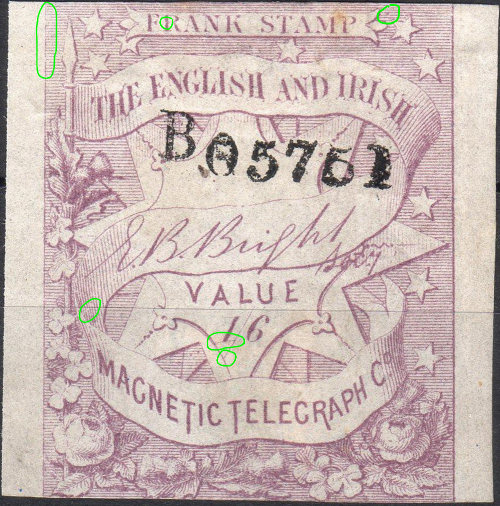 |
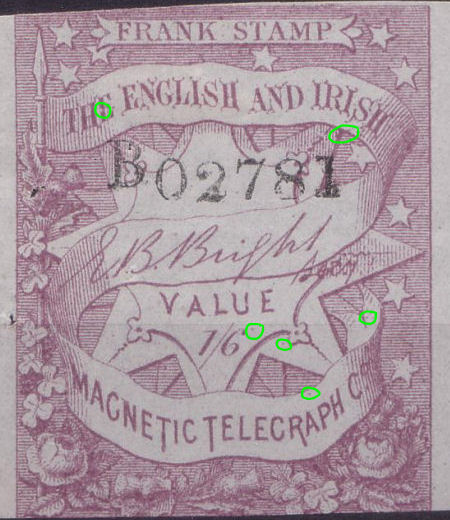 |
| Group 3, Column 1, Type ea on B05581. Quite a few flaws, some may be constant. The bottom of the '1' is very unusual, see also B05751 on the right. This is on the same strip as B05583, so I will 'park' this at 1e-pane 2 . |
Group 3, Column 1, Type eb on B05751. Quite a few flaws, the main reason for showing it here is the base of the '1' The value though is written slightly lower. I will 'park' this at 1e-pane 1. |
Group 3, Column 1, Type ec on B02781. A few flaws, very similar to the 0b-pane 2 stamp in remainder block. B02781 is on the same strip as B02785, so it should go at 1E-pane 1, however the stamp on the left is there. THIS IS AN ANOMALY. |
For Group 3, I have 6 scans from column 2, with none being small. Looking at these:
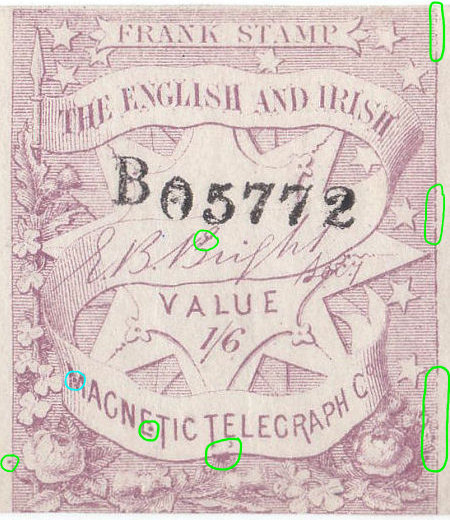 |
 |
| Group 3, Column 2, Type a on B05592, B05772 and a remainder. Quite a few common flaws, most match a remainder. B05772 is assumed to be 2A-pane 1. Remainder put there also. B05592 placed at 2A-pane 2.. |
Group 3, Column 2, Type b on B02712, B02822 and B05642. B05612 on the same strip as B05617. B05642 on the same strip as B05647. I will 'park' B05642 at 2B-pane 1, and B02712/B02822 at 2b-pane 2 |
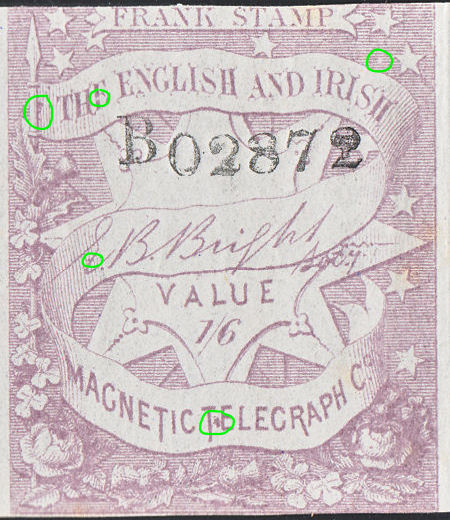 |
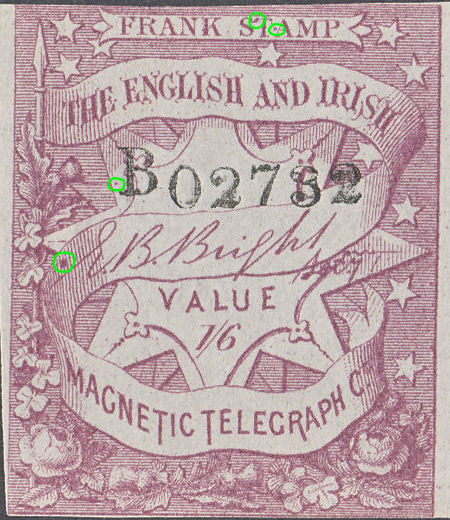 |
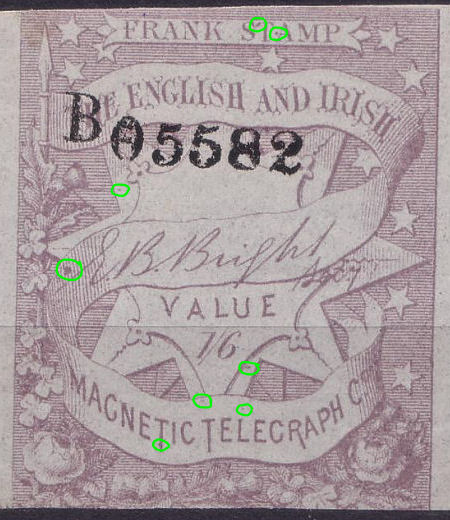 |
| Group 3, Column 2, Type c on B02872 (part of a strip). A few flaws that match a remainder from the opposite pane. The remainder matches B02516 which is mis-numbered. Designated as 2c-pane 2. |
Group 3, Column 2, Type da on B02732. A few constant flaws. More flaws are on B05582 I will 'park' this at 2e-pane 1 Note that the prominent flaw on the left can be confused with position 9A |
Group 3, Column 2, Type db on B05582. A few flaws, some may be constant. Four of these flaws are also on B02732 This is on the same strip as B05583/7, so I will 'park' this at 2e-pane 2 . |
For Group 3, I have 9 scans from column 3, with only 1 that is small. Looking at these:
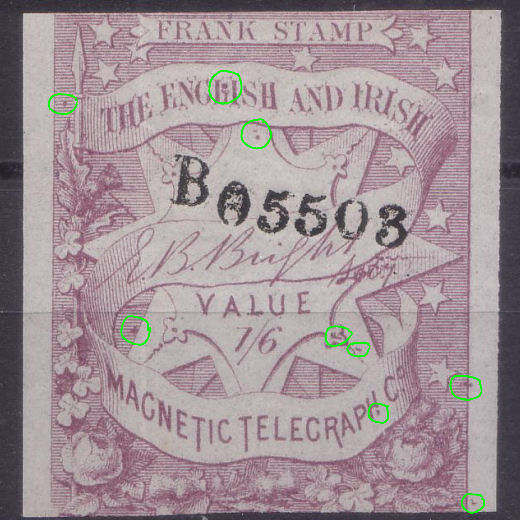 |
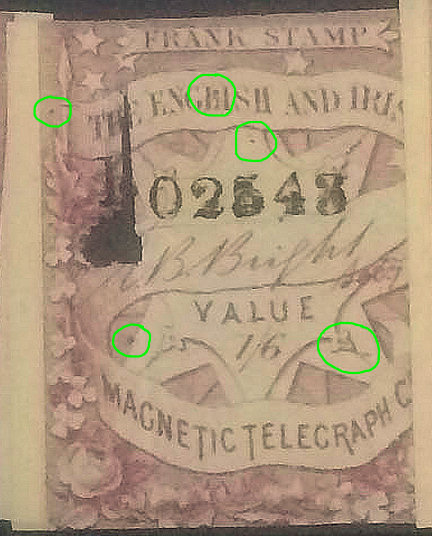 |
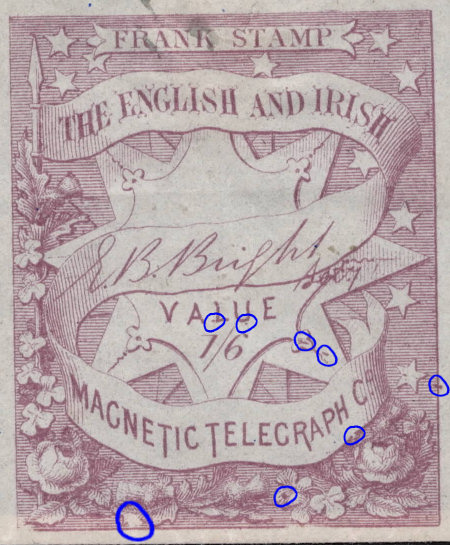 |
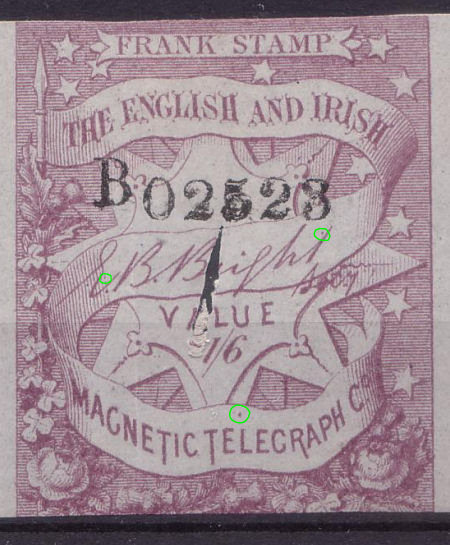 |
| Group 3, Column 3, Type a on B02633, B02843 and B05503. B02633 is on the same strip as B02645/6. I will 'park' this at 3d-pane 2 . |
Group 3, Column 3, Type a on B02543. This is on the same strip as B02547. This is a poor image but looks much like B05503. |
Group 3, Column 3, Type a on a remainder This shares many distinctive flaws with the last 2, but is missing some distinctive flaws also. I will place this at 3d-pane 1 . |
Group 3, Column 3, Type b on B02523 . Some features might be constant. This is on the same strip as B02524-6. I will place this at 3B-pane 1. |
 |
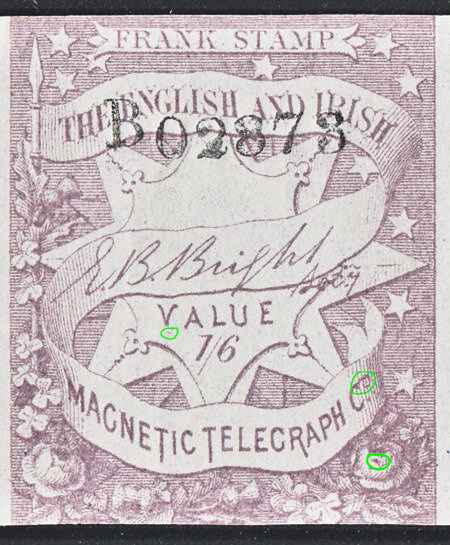 |
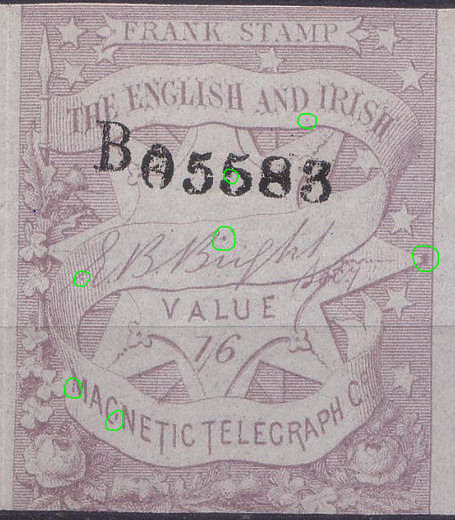 |
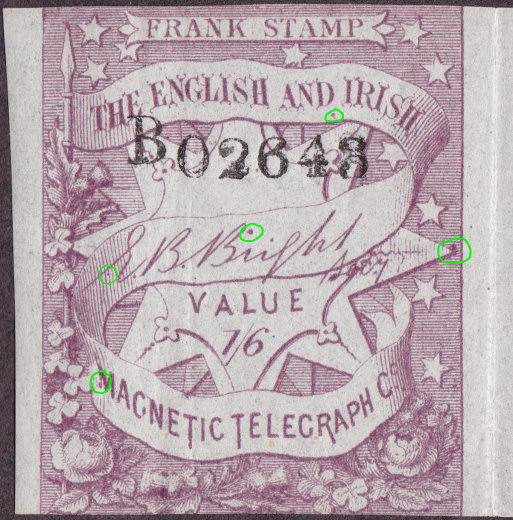 |
| Group 3, Column 3, Type c on B05513 and B05773. Also, missing a couple of flaws, on B05713 and a remainder. - B05773 assumed to be 3A-pane 1. Placing B05713 at 3A-pane 2. |
Group 3, Column 3, Type d on B02873 There are a couple of features that match 2 remainders. Designated as 3c-pane 2. The other pane is different. |
Group 3, Column 3, Type ea on B05583 and 2 remainders. This is like B02643(3e-pane 2), so I will 'park' this with it at 3e-pane 2. One remainder is a little different, 'parking' that at 3e-pane 1. |
Group 3, Column 3, Type eb on B02643. This is on the same strip as B02645, it matches B05583, but causes a conflict to combine them (B02781 not = B05581 (1e). I will 'park' this at 3e-pane 2 . |
For Group 3, I have 4 scans from column 4, with only 1 that is small. Looking at these:
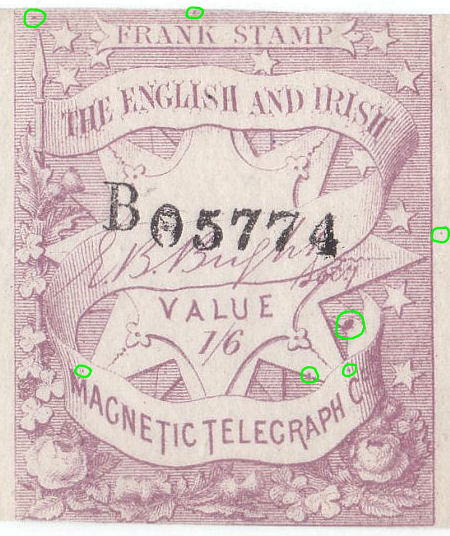 |
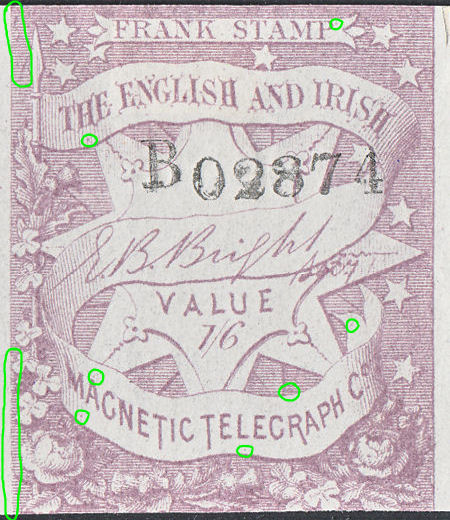 |
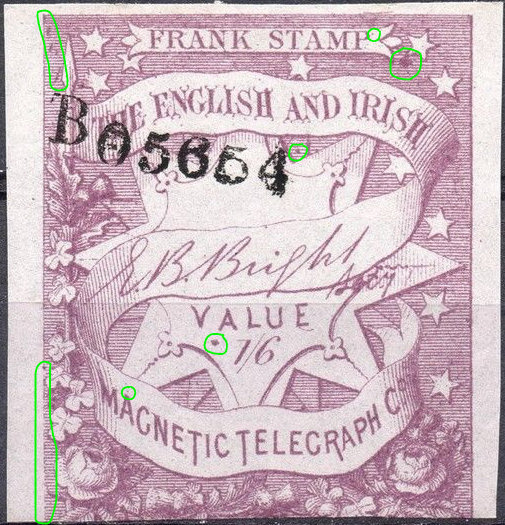 |
| Group 3, Column 4, Type a on B05774 and B05514. Also a remainder. Quite a few constant flaws. B05514 is in a pair with B05513, and B05515 is also known. Assumed to be 4A-pane 1. |
Group 3, Column 4, Type ba on B02874. A few flaws, some of which match a remainder. B02874 is part of a strip of 7 designated as pane 2. It may be wrong. Designated for now as 4c-pane 2. |
Group 3, Column 4, Type bb on B05654. This looks like the opposite pane to the previous stamp. That is designated, perhaps wrongly, as pane 2 Therefore designating for now as 4c-pane 1. |
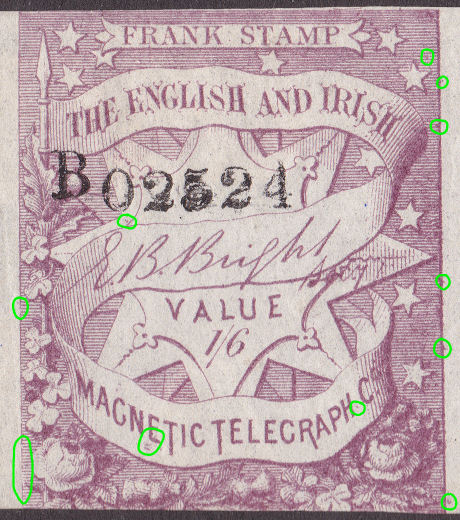 |
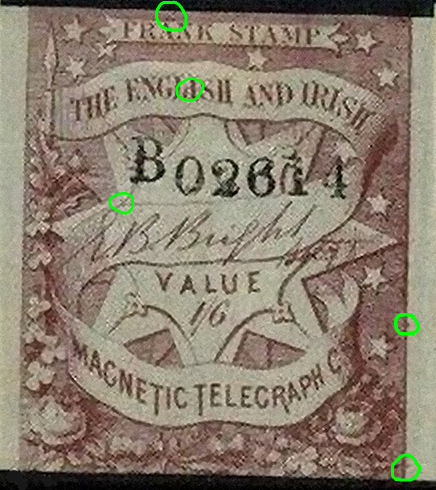 |
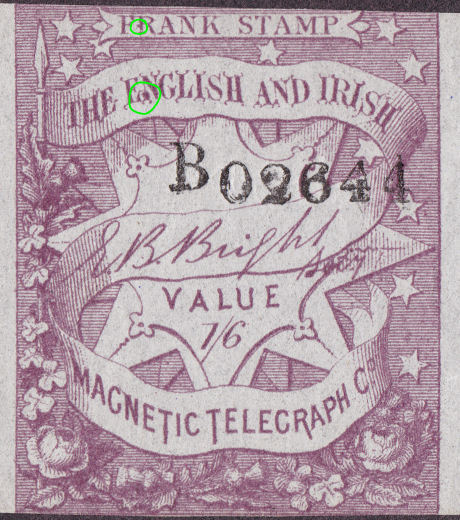 |
| Group 3, Column 4, Type c on B02524. This is on the same strip from B02523 to B02526. I will place this at 4B-pane 1. |
Group 3, Column 4, Type c? on B02614. This has similarities and differences to B02524. The value is also in a similar position. I will place this at 4B-pane 2 . |
Group 3, Column 4, Type d on B02644 and B05664. They look the same. B02644 is on the same strip as B02645, so I will 'park' them at 4e-pane 2 . |
For Group 3, I also have 13 scans from column 5, though 3 are rather small. Looking at these:
 |
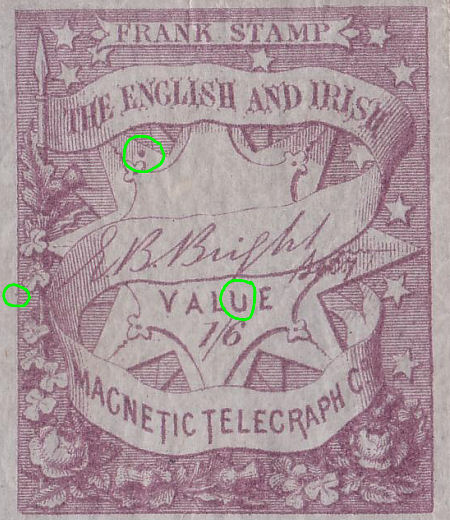 |
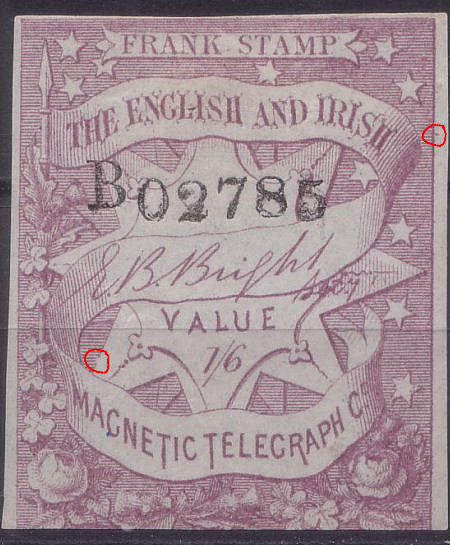 |
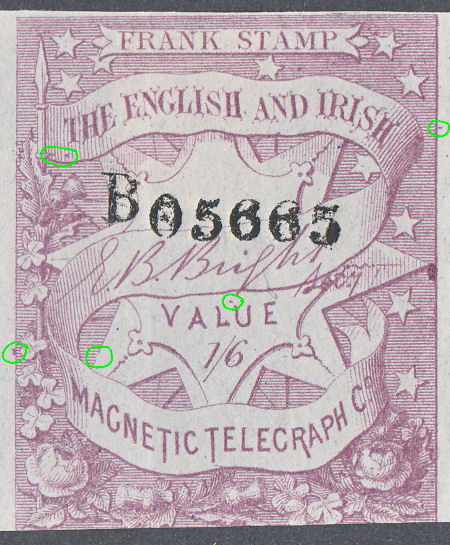 |
| Group 3, Column 5, Type aa on B02635, B02745 and B05675. I will 'park' this at 5d-pane 2 . |
Group 3, Column 5, Type ab on B02526 (mis-numbered), 2 remainders and a remainder block of 4 (5D-pane 1 ), a couple of flaws missing from 5d-pane 2. |
Group 3, Column 5, Type ba on B02785, B05625 and in a remainder block of 4 (5E-pane 1 ). |
Group 3, Column 5, Type bb on B02645 and B05665. like Type ba with extra marks. Strangely there is also a remainder with 4 of these marks but not the top-left. I will 'park' this at 5e-pane 2. |
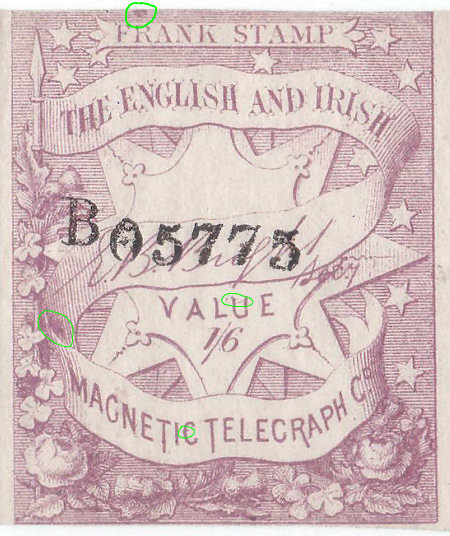 |
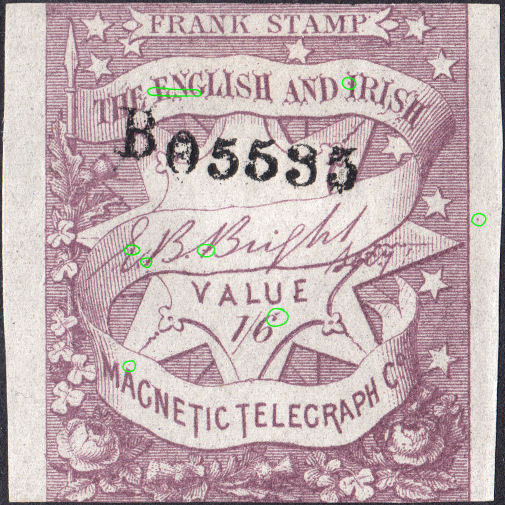 |
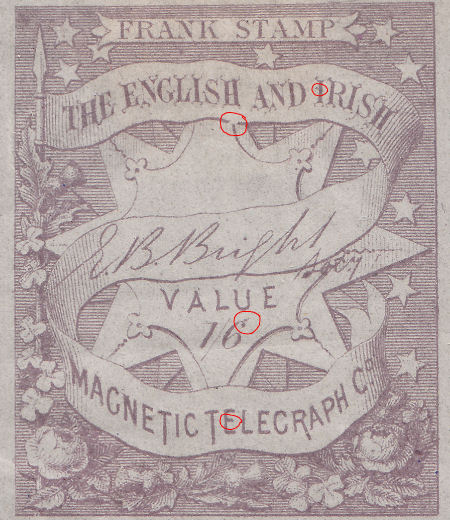 |
| Group 3, Column 5, Type c on B05775 and B05515. There are a number of constant features. Assumed to be 5A-pane 1. |
Group 3, Column 5, Type da on B02875 and B05535. There are a number of features, some of which might be constant. B02875 is on a long strip (B02871-B02877). See the next image. Designated as 5c-pane 2. |
Group 3, Column 5, Type db I have used a remainder here because it seems to match the poor image of B02725. This could be from the opposite pane of the previous. Thus 5C-pane 1. |
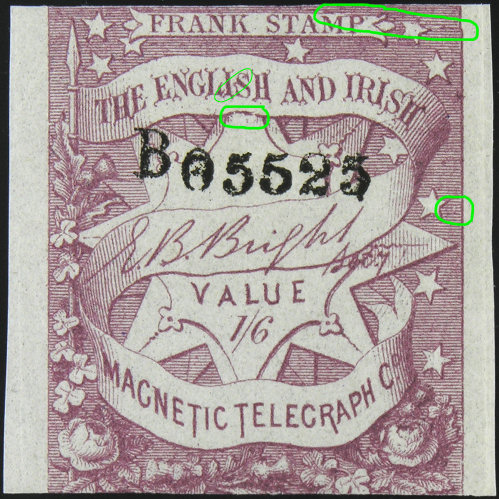 |
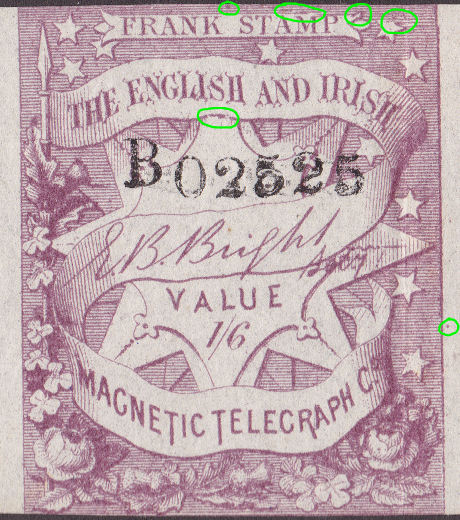 |
| Group 3, Column 5, Type e on B05525 and B05575. There several constant features, I'm not sure if these are from the same pane. Few options left, parking at 5b-pane 2. |
Group 3, Column 5, Type e on B02525. This is on the same strip from B02523 to B02526. placing at 5B-pane 1 . |
For Group 3, I also have 9 scans from column 6, though again 2 are rather small. A block of remainders shown above helps a lot:
One of them, B02516 was found to be mis-numbered.
 |
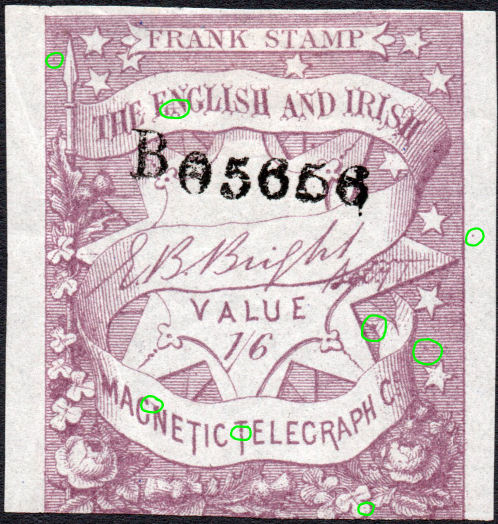 |
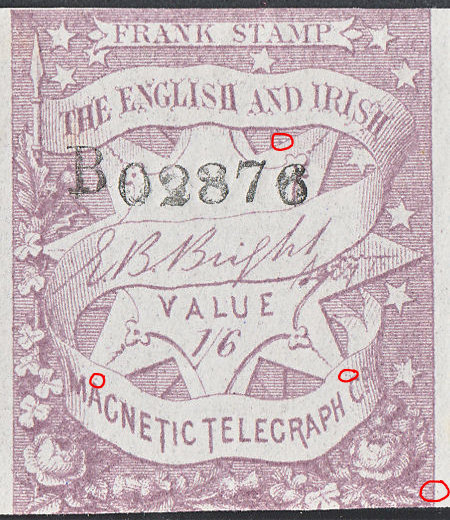 |
| Group 3, Column 6, Type a A few features on B05776, some should be constant. Some match a remainder with top selvedge. Assumed to be 6A-pane 1. |
Group 3, Column 6, Type b on B05656 and B02726 B05656 is on the same strip as B05654 and B02726 is on the strip with B02727. placing at 6C-pane 1 . |
Group 3, Column 6, Type b? on B02876. The red flaws can just about be seen on B02726. Designated as 6c-pane 2. Some things match. |
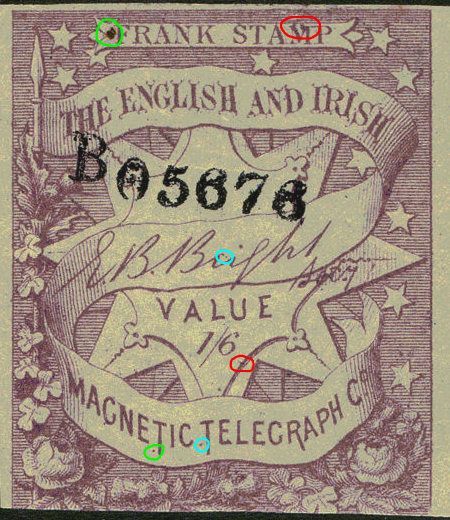 |
 |
 |
| Group 3, Column 6, Type d on B05676. The red flaws can be seen on a block of remainders above(6d-pane 2). Confusingly they are also on stamp B05647 ! The red and blue flaws are on B02636 (joins B02635) and another remainder. The green flaws are presumably non-constant. I will 'park' B05647 at 6d-pane 1 and B05676/B02636 at 6d-pane 2. |
Group 3, Column 6, Type e on B02646 and B05746. The red flaws can be seen on the remainder-block above. I will 'park' this at 6e-pane 2 on the understanding that it is a guess. Based on this guess, I will assign the remainder to 6E-panel 1 . |
Group 3, Column 6, Type c on B02526. This is on the same strip from B02523 to B02526. This is really similar to 5D. placing at 6B-pane 1 . |
For Group 3, I also have 10 scans from column 7, though a couple were mis-numbered column-6 stamps. Looking at these:
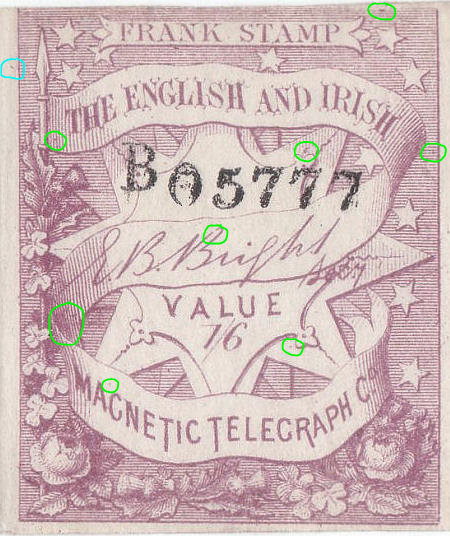 |
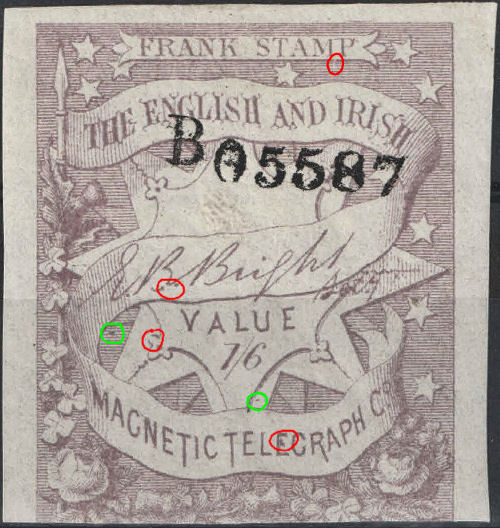 |
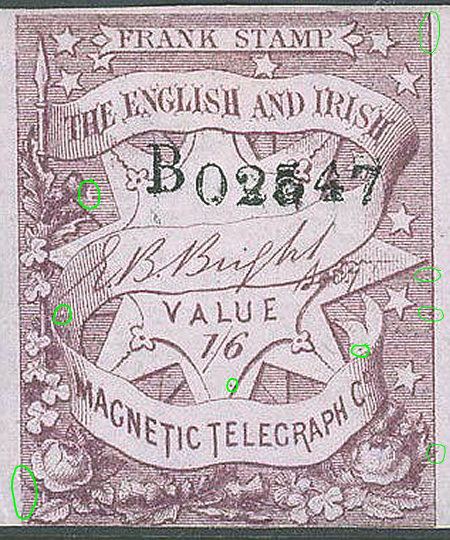 |
| Group 3, Column 7, Type a on B05547, B05697 and B05777. B05777 is assumed as 7A-pane 1. B05547 is missing a mark that the other two have, putting at 7a-pane 2 . |
Group 3, Column 7, Type b on B02647, B05587 and a remainder. B05587 is on the same strip as B05581/2, so I will 'park' this at 7E-pane 2 . |
Group 3, Column 7, Type c on B02547 and 2 remainders. I will 'park' these at 7D-pane 1 . |
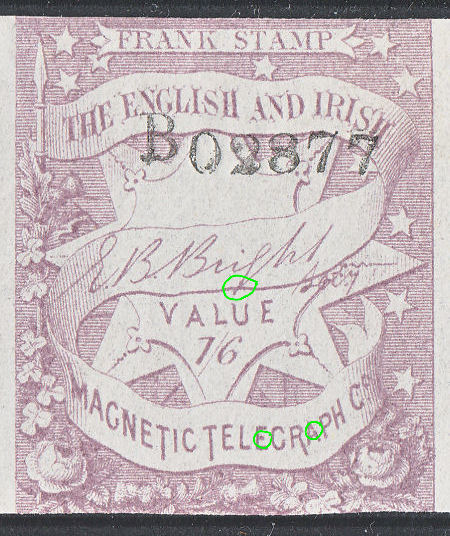 |
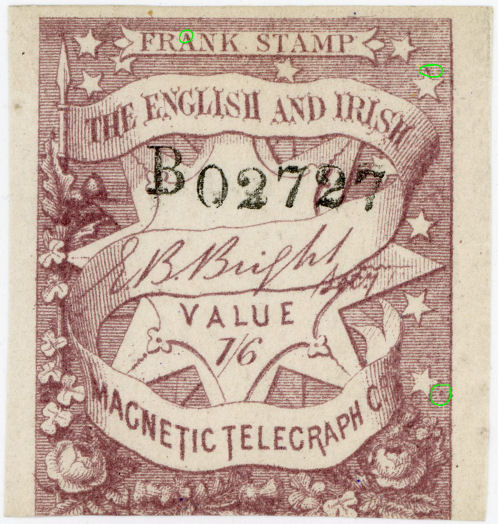 |
 |
| Group 3, Column 7, Type da Very little of significance on B02877, possibly some are constant. Designated as 7c-pane 2. |
Group 3, Column 7, Type db, on B02727. This is on the same strip as B02725/6 I will park this at 7C-pane 1 . |
Group 3, Column 7, Type e on B02717 and B05647. B05647 matches well B05676 and is on the same strip as B05642 B02717 is on the same strip as B02712. Due to reasons discussed above : Parking B05647 at 7B-pane 1 and B02717 at 7B-pane 2. |
For Group 3, I have only 8 scans from column 8 with one being small.
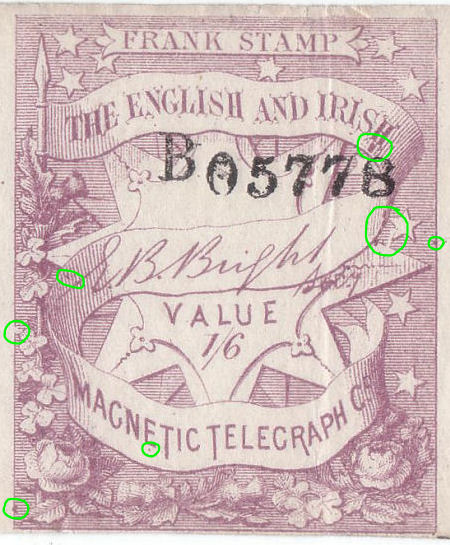 |
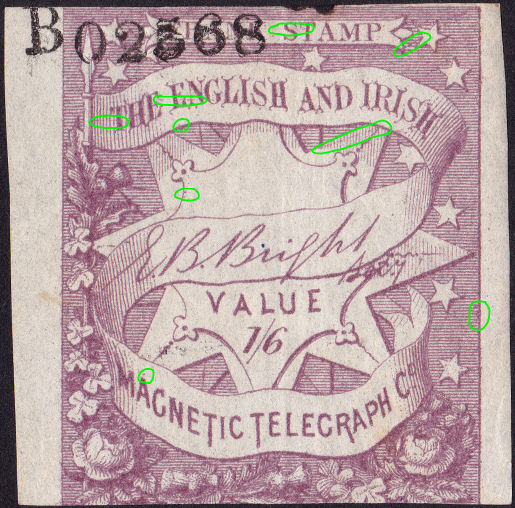 |
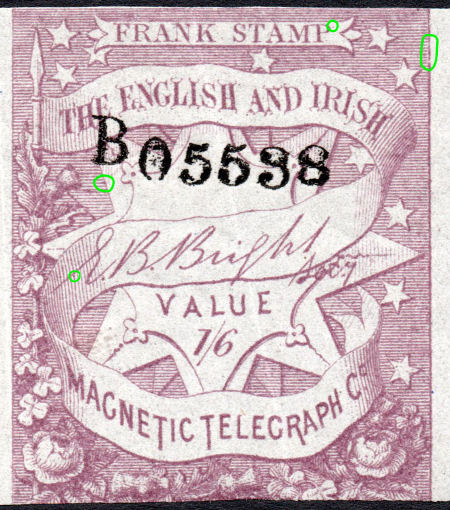 |
| Group 3, Column 8, Type a on B05718 and B05778. Several features, most match 2 remainders. B05778 Assumed to be 8A-pane 1. B05718 (on strip with B05713) and 1 remainder placed at 8A-pane 2. |
Group 3, Column 8, Type b on B02568 This has quite a few scratch marks, some match a remainder. I will 'park' this at 8b-pane 1 . |
Group 3, Column 8, Type c B05538 is on the same strip as B05535, B05539 & B05540 I will therefore place this at 8c-pane 2 . |
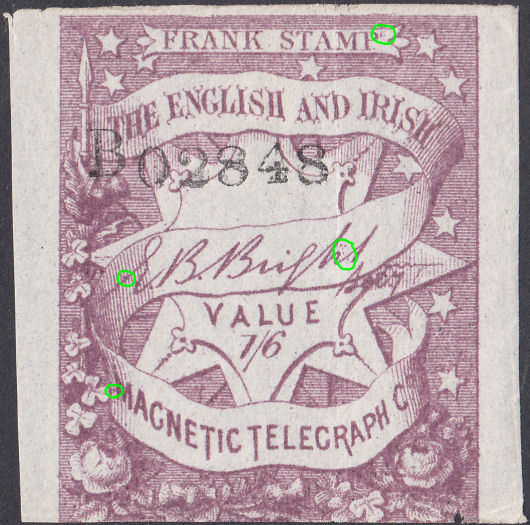 |
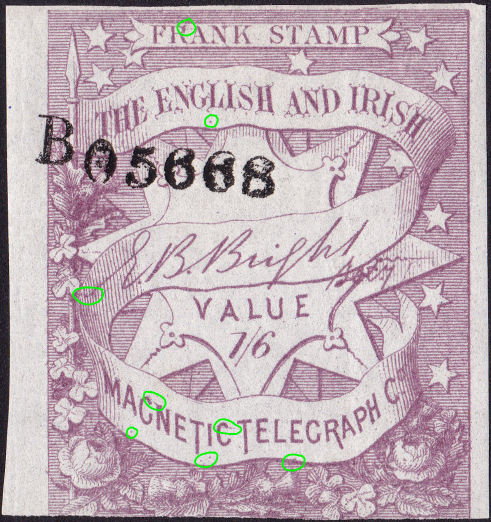 |
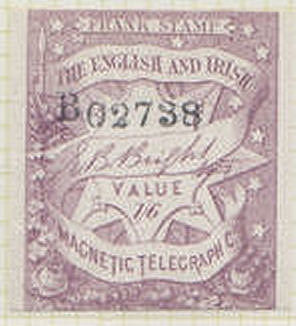 |
| Group 3, Column 8, Type d on B02848. A few features, some of which might be constant. This is on the same strip as B02843 (3d-pane 2) I will 'park' this at 8d-pane 2 . |
Group 3, Column 8, Type e on B02648, B05668 and B05748. Many features, most of which are constant. B05668 is on the same strip as B05665, B05748 is on the same strip as B05746. I will 'park' this at 8e-pane 2 . |
Group 3, Column 8, Type ? B02738 is on the same strip as B02732 (2E-1) I will therefore 'park' this at 8E-pane 1. |
For Group 3, I also have 5 scans from column 9 with one being small, there is though a block of remainders here.
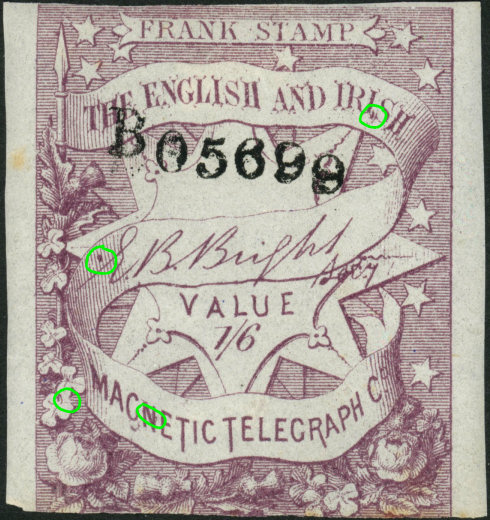 |
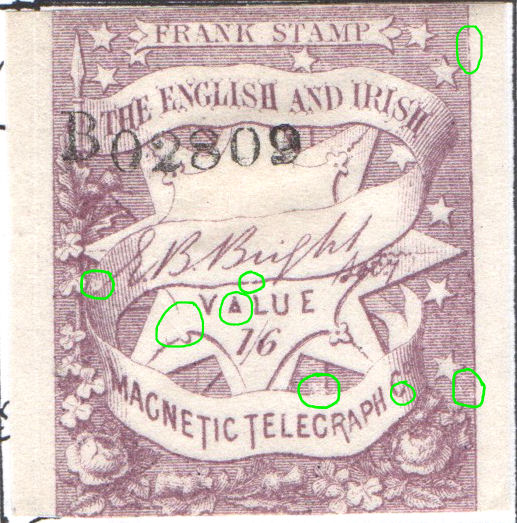 |
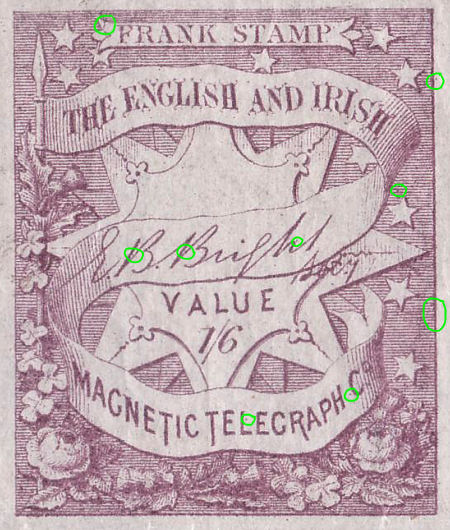 |
| Group 3, Column 9, Type aa on B05699, B05779 and a remainder. A few flaws that might be constant. Do not confuse this with position 2E Assumed to be 9A-pane 1. |
Group 3, Column 9, Type ab on B02809 which is on the same strip as B02810. Parking at 9a-pane 2, though it does not match 9a-p1 (B05779). |
Group 3, Column 9, Type b on top stamp in block of 4. Some flaws are also on B02689 - 'parking' at 9b-pane 1. Remainder 'Parked' at 9b-pane 2. |
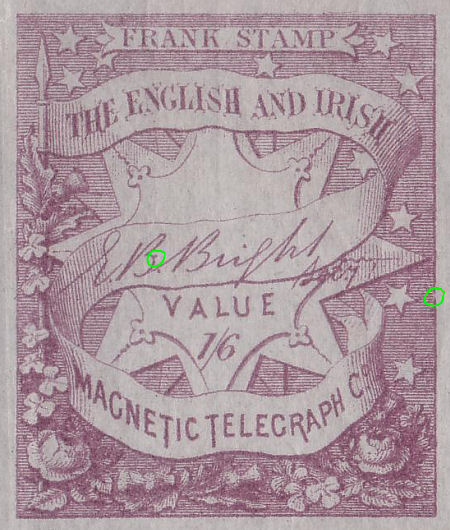 |
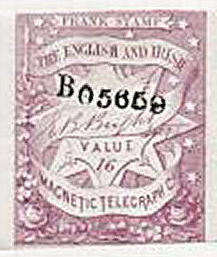 |
 |
| Group 3, Column 9, Type c on bottom stamp in block of 4. This matches B05539 and is on the same strip as B05535, B05538. and B05540. Placed at 9c-pane 2. |
Group 3, Column 9, Type c? on B05659. This is the same strip as B05654 at 4C pane-1. Not very helpful. 'Parked' at 9C-pane 1 . |
Group 3, Column 9, Type d on B02639 and 2 remainders. A few flaws that might be constant. This is on the same strip as B02635/6 I will park this at 9d-pane 2 . |
For Group 3, I also have 7 scans from column 0 plus a pair and block of remainders.
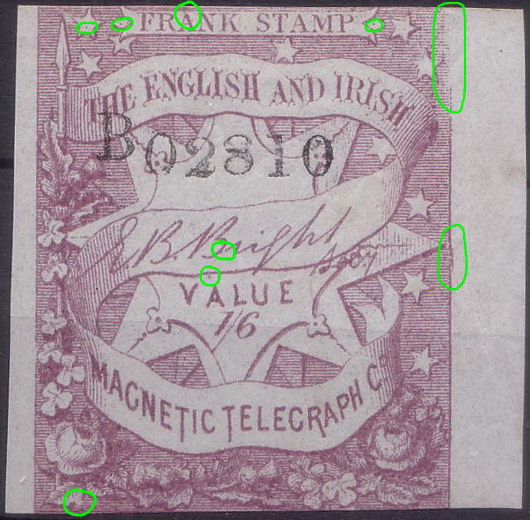 |
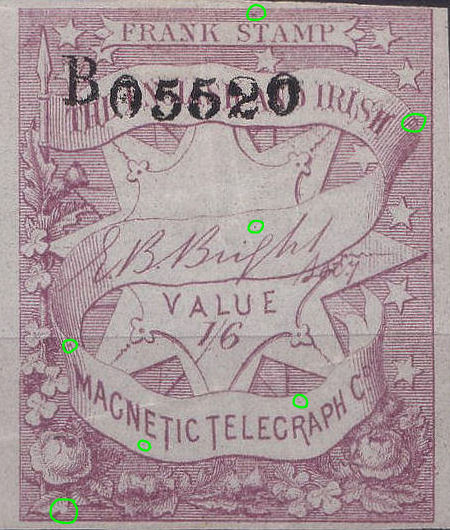 |
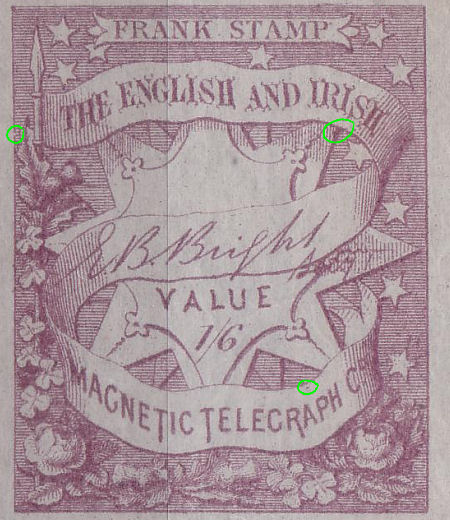 |
| Group 3, Column 0, Type aa on B2800 and B02810 which adjoins B02809. For the moment I am 'parking' this at 0a-pane 2 since it matches B05520 which is on the top row. B2809 does not match B05779 though. See intriguing. |
Group 3, Column 0, Type ab on B02660 and B05520. This is on the same strip as B05513/4 (3A and 4A pane 1). That would make this 0A-pane 1, but B02660 seems to have less flaws. |
Group 3, Column 0, Type b on the top of a vertical pair and similar to a remainder block. With the bottom similar to B02780. It is also very similar to B02781 ! I will 'park' this at 0B-pane 1 on the understanding that it is a guess. |
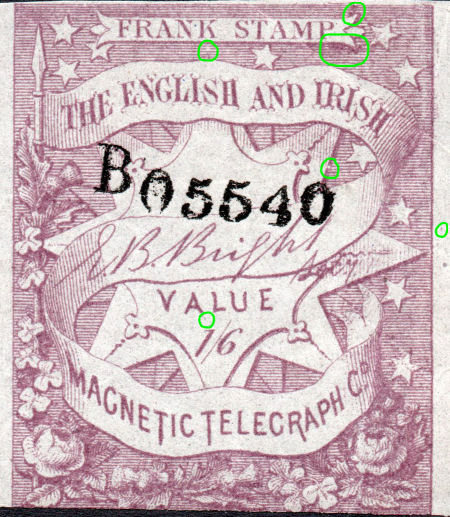 |
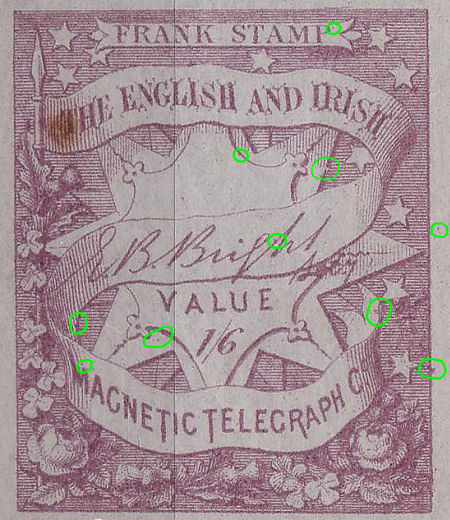 |
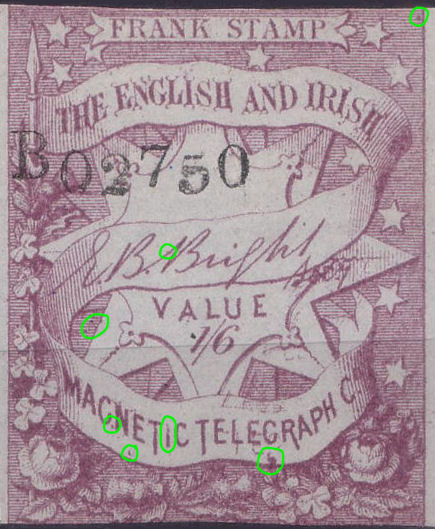 |
| Group 3, Column 0, Type ca on B02780, B05540 and a remainder block. B05540 is on strip B05538-40 I will 'park' this at 0C-pane 2 as it has fewer flaws than the other pane. |
Group 3, Column 0, Type cb on a remainder pair (bottom) This is like Type aa to the right, except the top flaw. placing this at 0C-pane 1 . |
Group 3, Column 0, Type d on B02750. Many features, most matching a remainder. This is on the same strip as B02745 (5d-pane 2) 'parking' at 0d-pane 2. There are 2 remainders with fewer flaws, 'parking' at 0d-pane 1 . |
 |
| Group 3, Column 0, Type e on B02770 and a remainder from the bottom of a pane. I am 'parking' this at 0E-pane 1. B02670 is similar, parking that at 0e-pane 2. |
Further scans invited.
I feel compelled at this point to list the false assumptions of authors when writing about the stamps of this company.
Philbrick & Westoby 1881, the earliest writer that I know of, gives 1853 as the date of these stamps.
They describe the stamps including the values and size, but give no information about sheet layout.
Walter Morley, in "The Fiscal Philatelist" March 1893(Pg.52/3) said :
"First issue 1853 (page 333), — This is given on thin white wove water-marked paper, gummed and unperforated, but no mention is made of control numbers.
Lately a number of these have been unearthed, and they are generally spoken of as reprints, whereas in reality they are genuine remainders.
I have before me what is probably an entire sheet - 100 stamps - formed by 10 rows of 10, measuring 16½ x 19 5/8 inches from
outer edge to outer edge of the stamps,
the distance between each stamp being ¼ inch.
I also possess four out of the five values mentioned on page 33, but with control numbers in black .... "
At the beginning he is quoting from page 333 of Philbrick & Westoby. The "water-marked paper" must be a typo as page 333 says "unwatermarked".
His later reference to page 33 is a typo for page 333.
Since Morley makes no mention of the value of his remainder sheet, he is presumably assuming the sheets to be all the same.
I would think that if there were tête-bêche pairs running across the middle he would mention it!
But then I would also think he would mention close-cropping at top and bottom of his other stamps too.
In his catalogue of 'Telegraph Stamps of the World' published February 1900, he lists tête-bêche pairs for the 1/- value only.
The '|ELEGRAPH' variety for the 1/-, 2/6 and 5/- values and states
that the 1/- and 4/- have 50 types to the sheet, but the others have 100 types to the sheet.
He makes no reference to a watermark in this, nor do later writers until Hiscocks says 'No watermark'.
Sometime between 1893 and 1900, Walter Morley learned an awful lot about these stamps.
Does anyone have any information as to documentation relating to this ?
The Stanley Gibbons Catalogue of 1899 says:
"Some values are printed in sheets of 50, and others in sheets of 100, and the figure of value varies in each stamp.
In the larger sheets, the lower half of 50 stamps is inverted with respect to the upper 50;
the two middle rows of the sheet are therefore tête-bêche.
They repeat this in their 1935 catalogue.
This would appear to be a misunderstanding of Morley on the assumption that his word 'Types' meant 'Stamps'.
Raymond Lister writing in 1961 says:
"Size of sheets: Some 50, some 100.
Those of 100 are printed with one half tête-bêche to the other, so that a row of tête-bêche stamps occurs in each of them.
This appears to have been taken directly from the Stanley Gibbons Catalogue, on the assumption that if it hadn't been corrected, it must be right.
He does not specifically say which values exist as tête-bêche pairs, presumably due to the ambiguity of Morley.
Steve Hiscocks (1982) says " ... in sheets of 50 or 100. In the latter case one pane of 50 was printed tête-bêche
below the other and tête-bêche vertical pairs are thus found.
All values derive from the same pattern with the actual values inserted by hand and thus differing slightly from stamp to stamp ..... The vertical spacing of the stamps
in the sheet was very close and top and bottom margins are very small or absent. ... Stamps without controls are remainders ... "
He has clearly taken this from Lister saying "Size of sheets: Some 50, some 100" rather than SG who
say more precisely "Some values are printed in sheets of 50, and others in sheets of 100.
This has led to his interpretation of each value being issued in two different size sheets.
On the basis of this, he then listed each value existing as tête-bêche pairs.
His observation of small margins top and bottom on the stamps with controls,
without having read Morley, causes him to make the assumption of close vertical spacing.
(He appears to not notice the contradiction of remainders having different spacing to issued stamps.)
Langmead & Huggins (2003) says: "Those stamps without controls are thought to be proofs since they always have wide top and bottom margins.
Issued stamps had very narrow horizontal spaces between stamps and those with controls are always cut into at top and bottom."
They go on to say "Printed in sheets of 50 and 100, the latter producing cut and uncut sheets, a pair of rows tête-bêche."
They have presumably noticed the inherent contradiction of Hiscocks, and without presumably having read Morley or seen
a remainder block of four, makes the logical assumption that the stamps without controls are proofs.
The main arguments against this is the large quantity of supposed 'proofs' and the lack of pieces of adjoining stamps above and below those with controls.
Additionally, proofs are not normally gummed.
John Barefoot (2013) says: "The stamps were printed in a sheet with two panes of 50, one pane inverted below the other.
Stamps from the central gutter can therefore be found in vertical tête-bêche pairs; these are only known for the 1/- but others could exist."
John Barefoot goes on to say "The spacing of the stamps in the vertical rows was very close, virtually touching, so good four-margin examples
cannot be found for the issued stamps. (However, proofs with good margins but without controls can be found more easily)."
John has presumably read Langmead & Huggins, as well as Hiscocks and agreed with the assessment. John makes no claims to be a specialist.
Steve Panting (2015) For my part, having seen that these were printed and numbered consistently in rows of 10 stamps, went on to assume that,
like other companies, they were also consistently numbered from top to bottom of the panes.
Ultimately I was forced to reject that last assumption. I then started finding evidence of mis-numbering.
Luckily, web-pages are easy to correct. The plating of these is not going to be easy.
I need all the scans I can get.
Last updated 12th. November 2023
©Copyright Steve Panting 2012/13/14/15/16/17/18/19/20/21/22/23 except where stated.
Permission is hereby granted to copy material for which the copyright is owned by myself, on condition that any data is not altered and this website is given credit.